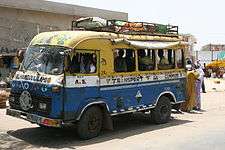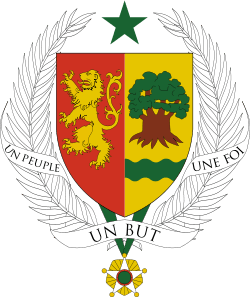Transport in Senegal
This article describes the system of transport in Senegal, both public and private. This system comprises roads (both paved and unpaved), rail transport, water transport, and air transportation.
Roads
The system of roads in Senegal is extensive by West African standards, with paved roads reaching each corner of the country and all major towns.
International highways
Dakar is the endpoint of three routes in the Trans-African Highway network. These are as follows:
- Cairo-Dakar Highway which crosses the edge of the Sahara
- Dakar-Ndjamena Highway which links the countries of the Sahel, also called the Trans-Sahelian Highway
- Dakar-Lagos Highway running along the West African coast and called by the Economic Community of West African States (ECOWAS) the Trans–West African Coastal Highway (though ECOWAS considers this route to start in Nouakchott, Mauritania).
Senegal's road network links closely with those of the Gambia, since the shortest route between south-western districts on the one hand and west-central and north-western districts on the other is through the Gambia.
Motorways
The only operational motorway in Senegal currently runs for 34 km. between Dakar and Diamniadio, and it is a toll motorway. A new part of the motorway, of 16.5 km. is currently under construction, which will reach the Blaise Diagne International Airport. Another section of 50 km. is also under construction, linking the airport to Thiès; and the 115 km. stretch from Thiès to Touba, the final destination of the planned motorway, will start under construction in the near future.
National roads
The most important roads in Senegal are prefixed "N" and numbered from 1 to 7:
- N1: Dakar – Mbour - Fatick - Kaolack – Tambacounda – Kidira – (Mali)
- N2: Pout – Thiès – Louga - St-Louis – Richard Toll – Ouro Sogui – Kidira - (Mali)
- N3: Thiès – Diourbel – Touba – Linguère – Ouro Sogui
- N4: Kaolack – (Trans-Gambia Highway) – Bignona – Ziguinchor – (Guinea-Bissau)
- N5: Bignona – Diouloulou – (Gambia) - Sokone - Kaolack
- N6: Tambacounda – Kolda – Ziguinchor – (Guinea-Bissau)
- N7: Tambacounda – Dar-Salam – Niokolo-Koba – Kedougou – Ségou – (Guinea)
Regional roads
- R20, R21, R22
- R30, R31, R32
- R60, R61
- R70
Railways
total: 906 km
narrow gauge: 906 km of 1,000 mm (3 ft 3 3⁄8 in) gauge (70 km double track)
Maps
Ground transport

There were an estimated 4,271 km of paved roads and 10,305 km of unpaved roads as of 1996.
Taxis (black-yellow or blue-yellow in color) are cheap, numerous and available everywhere in Dakar.[1] It is customary to negotiate the fare since most meters installed in the taxis are broken or missing.[1] For travel outside Dakar, public transportation is available but often unreliable and uncomfortable.[1]
Waterways
897 km total; 785 km on the Senegal river, and 112 km on the Saloum River.
Ports and harbours
Dakar has one of the largest deep-water seaports along the West African coast.[1] Its deep-draft structure and 640-foot-wide (200 m) access channel allows round-the-clock access to the port.[1] Its current infrastructure includes tanker vessel loading and unloading terminals, a container terminal with a storage capacity of 3000 20-foot-equivalent units, a cereals and fishing port, a dedicated phosphate terminal and a privately run ship repair facility.[1] The port’s location at the extreme western point of Africa, at the crossroad of the major sea-lanes linking Europe to South America, makes it a natural port of call for shipping companies.[1] Total freight traffic averages 10 million metric tons.[1]
Airports

There were an estimated 20 airports in 1999. The Léopold Sédar Senghor International Airport at Dakar is the hub of the sub-region.[1] Dakar is linked to numerous African cities by air, and daily flights go to Europe.[1] Delta Air Lines flies daily to/from Atlanta/Dakar/Johannesburg.[1] South African Airways flies daily to New York and Washington, D.C. from Johannesburg via Dakar.[1]
A new international airport which carries the name of Blaise Diagne is under construction at Diass.[2]
Airports - with paved runways
total: 10
over 3,047 m: 1
1,524 to 2,437 m: 7
914 to 1,523 m: 2 (1999 est.)
Airports - with unpaved runways
total: 10
1,524 to 2,437 m: 5
914 to 1,523 m: 4
under 914 m: 1 (1999 est.)
See also
References
- 1 2 3 4 5 6 7 8 9 10 11 12 Senegal Country Commercial Guide 2008. U.S. Commercial Service (2008).
 This article incorporates text from this source, which is in the public domain.
This article incorporates text from this source, which is in the public domain. - ↑ Aéroport International Blaise Diagne
External links
![]() This article incorporates public domain material from the CIA World Factbook website https://www.cia.gov/library/publications/the-world-factbook/index.html.
This article incorporates public domain material from the CIA World Factbook website https://www.cia.gov/library/publications/the-world-factbook/index.html.
